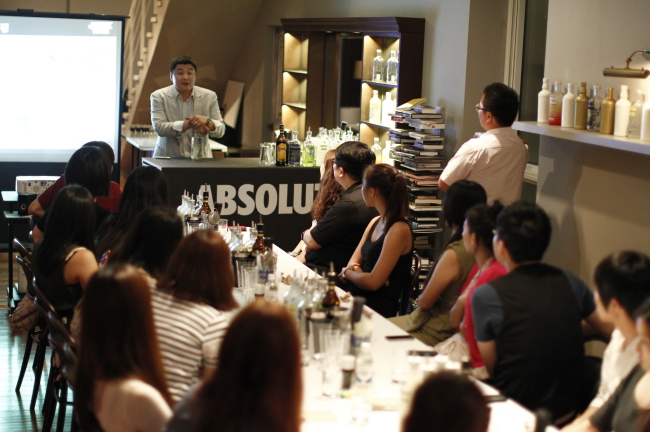[Weekender] Bomb shots evolve into cocktail culture
By Kim Yon-sePublished : April 18, 2014 - 21:20
Korean drinkers may have a knack for making tasty cocktails.
Ranging from the traditional boilermaker, which is dubbed poktanju, to trendy cocktails more recently, a large proportion of popular alcoholic beverages here are mixed liquors. More businesses are also moving quickly to take advantage of the long-standing unique drinking culture.
“In Korea, a liquor product can be successful only when it tastes good mixed with other liquors or beverages,” said an official of Mackiss, a high-end soju brand launched last year as a mixing spirit for diverse cocktails.
The birth of poktanju, a cocktail of beer and liquor such as soju or whiskey, dates back to the 1970s when binge drinking emerged as a trend.
Ranging from the traditional boilermaker, which is dubbed poktanju, to trendy cocktails more recently, a large proportion of popular alcoholic beverages here are mixed liquors. More businesses are also moving quickly to take advantage of the long-standing unique drinking culture.
“In Korea, a liquor product can be successful only when it tastes good mixed with other liquors or beverages,” said an official of Mackiss, a high-end soju brand launched last year as a mixing spirit for diverse cocktails.
The birth of poktanju, a cocktail of beer and liquor such as soju or whiskey, dates back to the 1970s when binge drinking emerged as a trend.

Amid rapid economic growth, salaried workers were forced to work hard and found no way to relieve their mounting stress other than heavy drinking. Poktanju literally bombarded the drinker with a heavy dose of alcohol.
The original poktanju was made with soju (called somaek, meaning beer plus soju). Korea’s top two beer giants ― OB and Hite ― also competed fiercely to steal market share from each other in the soaring poktanju market. Then they introduced new, more carbonated beer products to pair better with hard liquor for poktanju.
Then high-income businesspeople opted for whiskey poktanju when they served clients in the early and mid-1990s, the height of the bullish economy.
Since then, Korea has become one of the top whiskey-consuming countries.
Now Korea is the No. 1 alcohol consumer in Asia, and beer poktanju remains one of the most favored cocktails among office workers on a night out.
But young generations are moving away from the binge drinking habits. They now enjoy drinking in diverse ways and are creating a new drinking culture with their own favorite cocktails with imported liquors such as vodka and tequila.
Sales figures of liquor products also reflect the evolving trend in recent years. Since hitting a peak of 22.5 million liters in 2010, whiskey imports slid to 21.4 million liters in 2013.
Meanwhile, imports of white spirits such as vodka, rum and tequila soared during the same period. Vodka imports more than doubled from 10 million liters in 2010 to 26 million liters in 2013.
“I wouldn’t say whiskey consumers are replaced with those enjoying white spirits, considering their price differences. I think a new breed of drinking culture is emerging,” said Brian Lee, general manager of Bacardi Korea, a top player in the rum and tequila categories.
The growth of the white spirit market has also been fueled by a growing number of young drinkers who enjoy homemade cocktails.
Young drinkers share cocktail recipes online, while companies, including the Korean unit of France-based liquor group Pernod Ricard, operate mixology classes on a regular basis as an effective marketing tool to lure young, fashionable drinkers.
“Younger generations are more open to new culture. When they get older and are equipped with more spending power, they will create a huge consumer group for the white spirit market in the near future,” Lee said.
By Lee Ji-yoon (jylee@heraldcorp.com)







![[KH Explains] How should Korea adjust its trade defenses against Chinese EVs?](http://res.heraldm.com/phpwas/restmb_idxmake.php?idx=644&simg=/content/image/2024/04/15/20240415050562_0.jpg&u=20240415144419)










![[Today’s K-pop] Stray Kids to return soon: report](http://res.heraldm.com/phpwas/restmb_idxmake.php?idx=642&simg=/content/image/2024/04/16/20240416050713_0.jpg&u=)